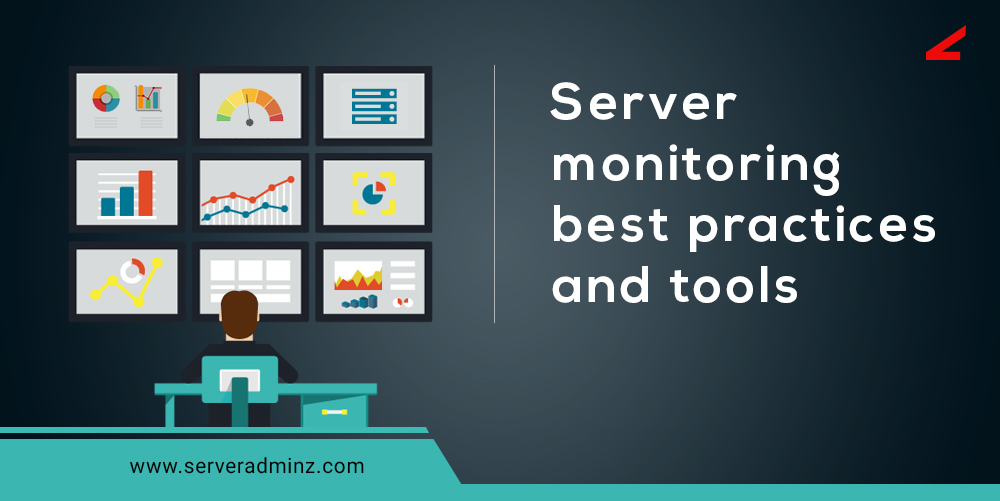Top Server Monitoring Tools and Best Practices
It can be said that keeping an eye on your web server will increase the productivity and security. Most of the hosting companies do their monitoring and spend some extra cash on it as monitoring is an important aspect of hosting industry. Server administrators can monitor daily activities on a particular server, services associated with it and the most prominently we get alerts if suppose any server goes down or any services like Apache, Nginx or Mysql.
It is essential to monitor server resources threshold such as disk I/O, free memory and disk usage on each partition if any and certainly the web traffic in and out of the server.
Monitoring includes the following considerations
- HTTP and HTTPS traffic, especially if a server is shared by more than hundreds of websites
- End user connections to the server
- The health and possible symptoms of server hardware (in Linux server we need to analyze the kernel parameters)
- Server uptime
- Virtual machines on a dedicated server(node), for an example, unless there is monitoring on OpenVZ servers, there are more chances to servers go down
- Mysql or any other SQL platform that particular server associated
- Other web applications
Tools Involved
At first, we need to select appropriate monitoring tool for monitoring a server. The best practices for server monitoring begins when we choose a monitoring tool. There are available many applications for the purpose of web server monitoring and most companies use those applications effectively.
Let’s take a moment to analyze some of the best monitoring tools
Zabbix is a powerful tool which considered as an enterprise level software for the sole purpose of monitoring. We can get it installed on Linux, Solaris, Windows, MacOS X, FreeBSD etc.
We can configure the tool as we desire such as we can add nodes, virtual/dedicated servers and can implement alerts for each and every services, downtime, bandwidth usage and hardware failure in nodes(OpenVZ, KVM), RAID alerts and so on.
Zabbix give alerts in the form of bling the particular down issue(services or server name) and the color change(mostly reddish and yellow colors to notify easily)
Nagios is a popular one among server administrators and it gives a simple and user-friendly interface to admins. It has the best web interface to check system health from any place. We can do health monitoring on computers and also phones.
Nagios server can be installed on any VM or dedicated server and Nagios client software needs to be installed on client servers which we need to monitor.
As Zabbix do, Nagios can also be configured based on our needs, individuals can set different configuration files for separate server or server groups and can define rules for every service such as ping, HTTP traffic, MySQL, root partition alerts, swap space, mail queues and of course server down.
Nagios gives alerts in the form of color change and individuals can identify the reporting server at ease. Nagios can be configured to provide sound alerts as well, which is more efficient and alerted if we really want to do the monitoring for the servers.
Thus, this hazardless tool is used by millions of users worldwide and it became favorite among web hosting providers
This software is particularly used in many of the web servers. This monitoring tool identifies status, availability, and health of server hardware in minutes. It gives the status of critical hardware components like power supply, CPU, battery, fan speed, temperature, and more. It provides graphical visibility to users network without any additional work or tools.
This tool has paid version which can be configured effectively on your needs.
Elements associated with server monitoring
Alerts or Notifications
Notifications are the effective way to communicate one monitoring tool to IT administrators. There are several forms of alerts which are commonly used by above tools.
Email alerts: We can set alerts on any server/service down and we can prioritize the servers( we don’t need alerts for every server)
Desktop popups: It is a needful one that we can get alerted via our working PC/laptops by popping out alerts/information.
GUI alerts: Every monitoring tool has it’s own GUI platform which is designed in such way that to show instant alerts if there any down issue happen.
Health
It shows the statistics of a variable being monitored.
Administrators need to know the current status of servers and the services associated.
Thresholds
We can set threshold frequencies for different resources such as root partitions, swap area, and free memory. Likewise, the tool will indicate if the value exceeded or on the peak end.
Events
We can call events as situations where a service got stopped or hanged in servers such as PHP, HTTP or MYSQL. The services run on a web server should keep alive and administrators want to know if suppose any occurrence of downtime in these services.
A Web server is a platform for hosting files and applications – each of them has its own unique characteristics and demands. So, any best practices must be applied on a case-by-case basis. Ultimately, the administrator has the right to decide which measures are most appropriate for the particular environment and use case. The three big things to keep in mind when doing any sort of server/system monitoring are:
Identify as many problems as possible.
Identify problems as early as possible.
Generate a few false alarms as possible.
If you want to learn more about server management tools, check out our related blog topics
Best Free Server Monitoring Tools for Linux and Windows
Best Server Administration Tools for Linux
10 Top Free Server Monitoring Tools for Server Administrators
5 Server Management Tools to Ensure a High Performing Website
ServerAdminz provides Outsourced 24/7 Technical Support, Remote Server Administration, Server Security, Linux Server Management, Windows Server Management and Helpdesk Management to Data centers, Hosting companies and ISPs around the world. We specialize in Extended Server Security, Server Hardening, Support of Linux/UNIX/Windows servers, products and services.
ServerAdminz is a server support company specialized in Outsourced 24/7 Web Hosting Support, Remote Infrastructure Management, NOC, Cloud and Enterprise Security Services. With over 10+ of years of experience in working with major Data Centers and ISPs with 130+ experienced technicians, we continue to manage more than 49,000 servers from 85+ countries and has bagged 5 international awards.
If you have any queries regarding server monitoring, share your thoughts and our representative will get back to you.
[two_third last=”yes” spacing=”yes” center_content=”no” hide_on_mobile=”no” background_color=”” background_image=”” background_repeat=”no-repeat” background_position=”left top” border_position=”all” border_size=”0px” border_color=”” border_style=”” padding=”” margin_top=”” margin_bottom=”” animation_type=”” animation_direction=”” animation_speed=”0.1″ class=”” id=””]








Leave A Comment
You must be logged in to post a comment.